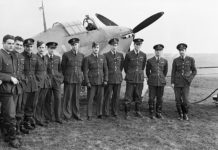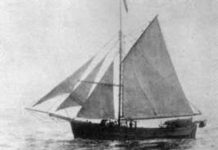For almost two centuries, the Burlington Canal has played a vital role in marine transportation and commerce on the Great Lakes. Initially constructed in the late 1820s, and rebuilt several times since then, the canal cuts through the giant sandbar at the head of Lake Ontario known as Burlington/Hamilton Beach, providing access to the natural harbour formed by Burlington Bay and thus spurring Hamilton’s development as a centre of trade and commerce.
The canal is also the source of an enduring Ontario haunting: the ghost of Jem Horner.
Prelude
During the winter of 1829-30, the wooden piers lining the sides of the canal were swept away by a series of savage gales. To prevent a recurrence, the Government of Upper Canada decided that the new piers would be built on stone foundations. Construction began in the spring of 1830. The massive stones required to create the foundations were pulled from the bottom of Lake Ontario by men (known as “stonehookers”) using long iron bars, two-prong rakes or derricks. They were then loaded onto large, flat-bottomed scows and transported to the worksite, where they had to be lifted from the scows and hurled into large timber cribs to form the foundations for the new piers. This lifting and hurling was physically exhausting and dangerous. The men who eked out a meagre living performing this wretched task were called “stone scowmen”: they tended to be rugged, hardened and physically intimidating.
Jem Horner was a stone scowman but, even amongst these tough customers, he stood out as a cruel, violent and hateful individual who was both feared and loathed by his confederates.
The Accident
On a rough, blustery morning that spring, Horner and some other men were unloading stones from a scow when a powerful wave struck the vessel. Horner lost his balance and fell overboard between the scow and the crib. As he struggled frantically to pull himself back onboard, another large wave slammed into the rock-laden scow, shoving it up against the crib. Horner’s left leg, caught between the two objects, was crushed to a bloody pulp by the force of the impact. Still, he managed to drag his shattered limb over the side before collapsing onto the bottom of the boat, trembling, bleeding and shrieking in agony.
The other stone scowmen quickly sized up the situation, pragmatically concluding that Horner’s presence would hinder their unloading operations and thus reduce their earnings for the day. Clearly, action was called for. A few of them carried him off the scow and then north along the sandbar for about half a mile to an old, abandoned building. They left him there alone, moaning and screaming in pain and crying out for help.
Horner’s Death and Aftermath
Towards evening of the same day, a passer-by heard Horner’s cries and, venturing into the building, found the critically injured man. This Good Samaritan immediately went in search of a messenger and, upon finding one, dispatched him to Hamilton to find and bring back medical aid. However, by the time the doctor – a prominent local surgeon named William Case – arrived, Horner had gone berserk from the pain of his injuries and the leg itself was beyond saving. Dr. Case amputated the mangled limb then and there, and gave it to another scowman named Wheeler with specific instructions to bury it. Despite the doctor’s best efforts, Horner died late that night.
Dr. Case was deeply troubled by Horner’s suffering, so an inquiry was called into the circumstances surrounding his death. During the court of inquiry’s deliberations, the scowman Wheeler was directed to disinter the shattered leg and produce it. However, Wheeler informed the court he had not, in fact, buried the leg: instead, he had preserved it for burial with its former owner by placing it in a keg of whiskey. The keg was duly brought forward and opened before the court, revealing the horrific (and putrid) remains of Horner’s leg, but none of the preservative whiskey. Shortly thereafter, it came to light that three of Wheeler’s fellow scowmen had seen him disappear with the keg on the night of Horner’s death and, after considerable searching, had found its hiding place. Unaware of what Wheeler had added to the keg in the interim, the three rogues had subsequently visited it on several occasions, removing the bung and helping themselves liberally to the whiskey. Their reactions upon learning the actual contents of the keg are not recorded.
The Haunting
Jem Horner did not find peace when death released him from his suffering. His one-legged ghost is said to roam the section of the sandbar north of the Burlington Canal. Some people believe he’s seeking the lost limb that didn’t accompany him to the grave: others claim he’s looking for the men who left him to die so many years ago, intent on extracting some terrible vengeance. And the ghost has not kept silent. For years after Horner’s death, travelers passing that dilapidated old building on the sandbar reported hearing the screams of a man in mortal agony. Finally, in an effort to rid the area of these spectral sounds, the building was demolished. However, people continued to hear ghostly echos of blood-curdling screams, faint yet chilling, swirling about them when they walked the sandbar late at night.
Sources:
- Campbell, Marjorie Freeman. A City and a Mountain: The Story of Hamilton.Toronto: McClelland and Stewart Limited, 1966.
- Smith, Barbara. Ontario Ghost Stories. Vancouver: Lone Tree Publishing, 1998
- Notes on the history of the Burlington Canal compiled by Burlington Public Library in cooperation with Joseph Brant Museum.







